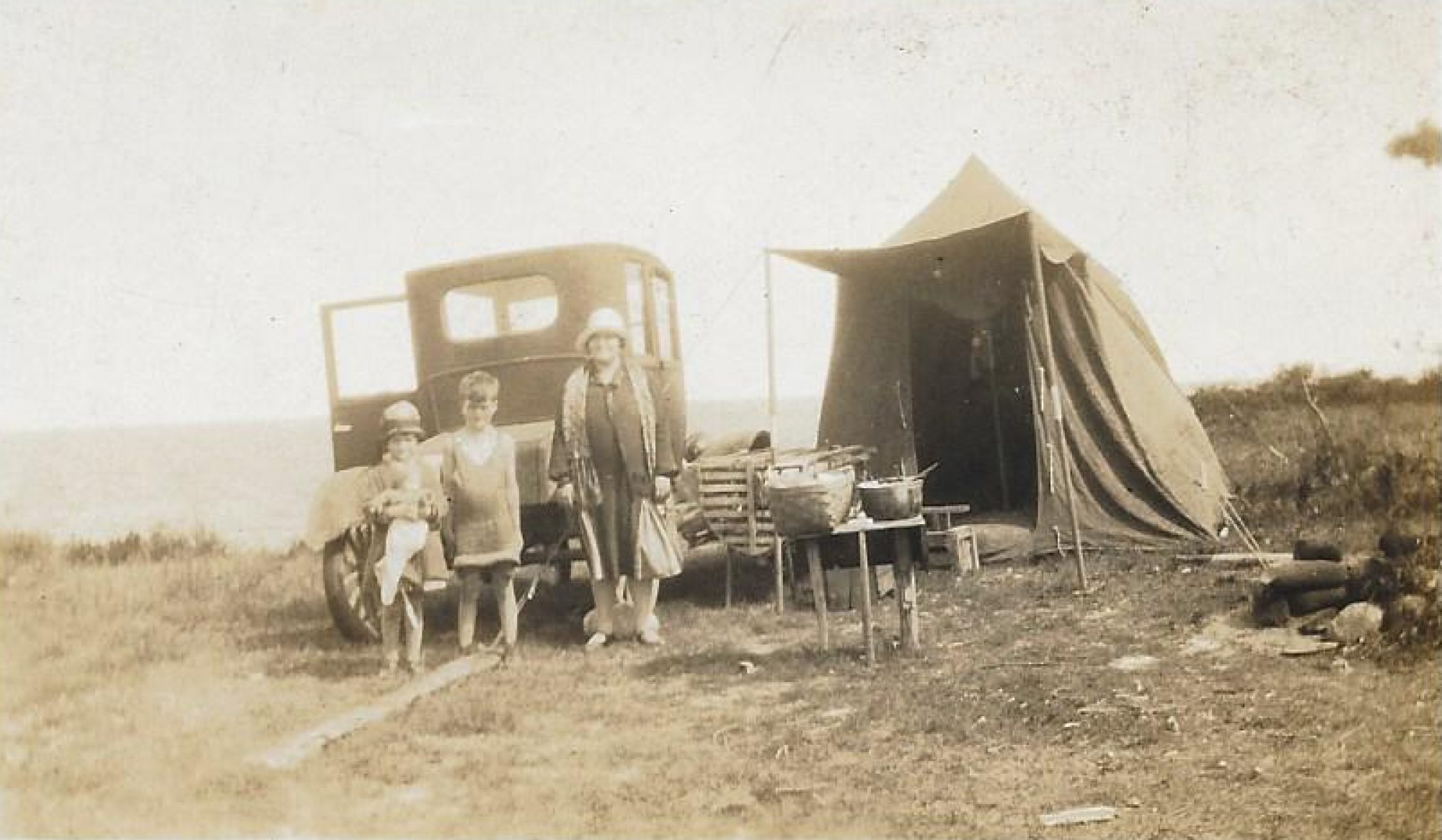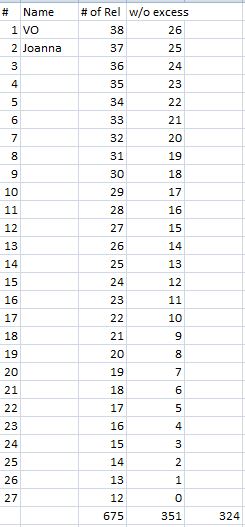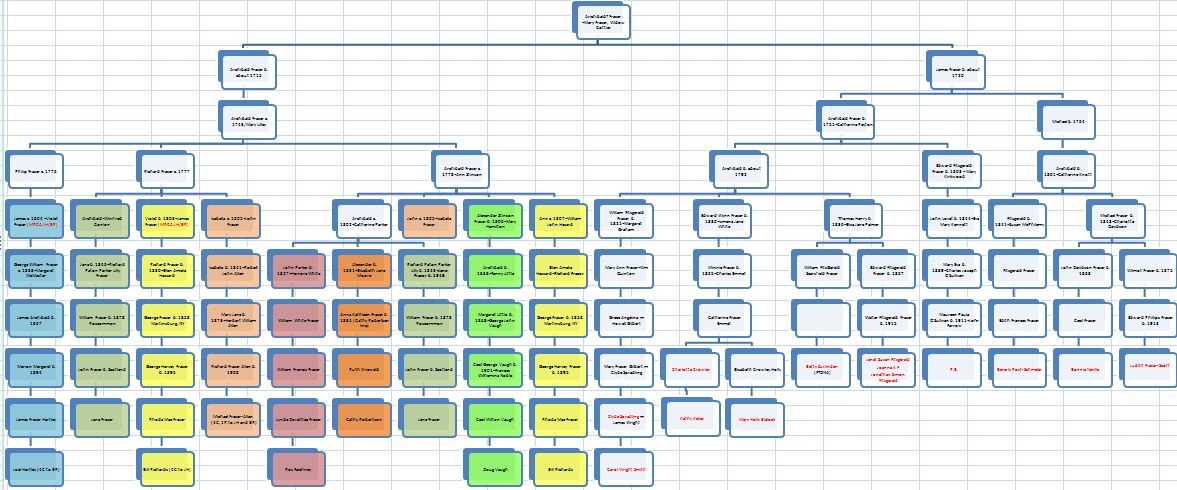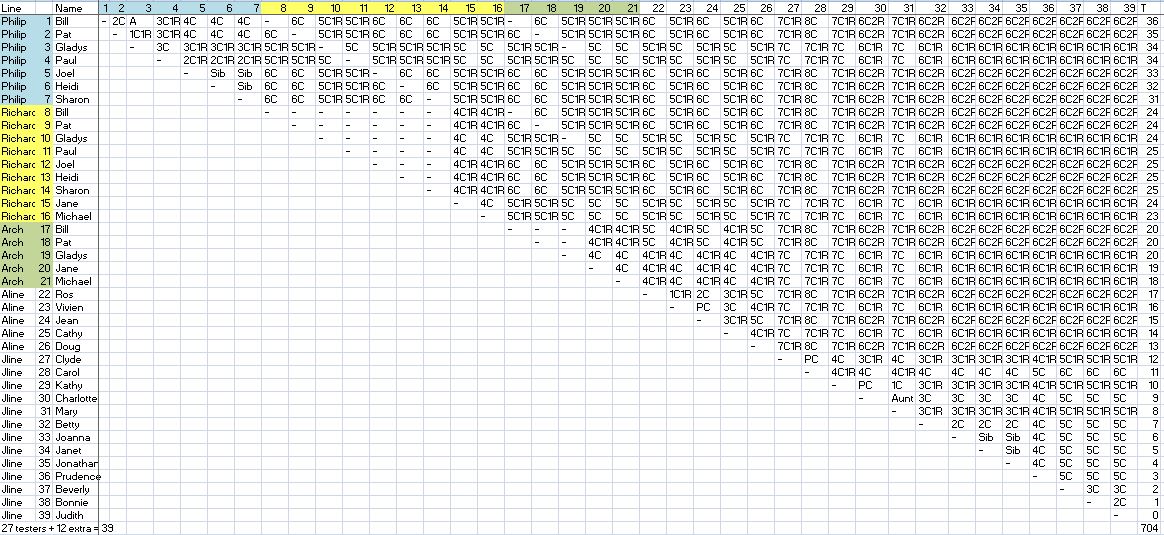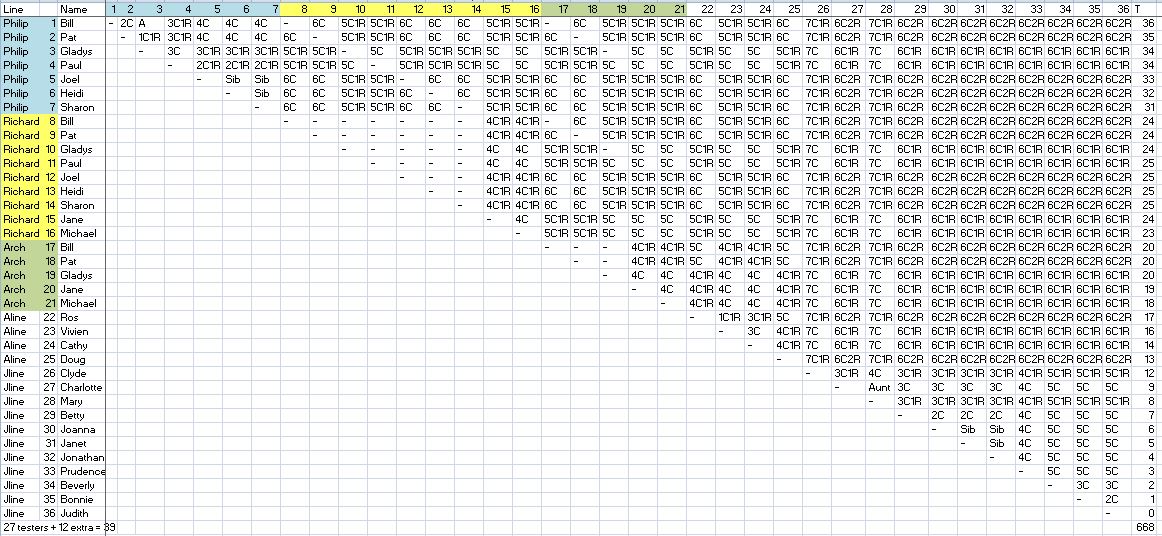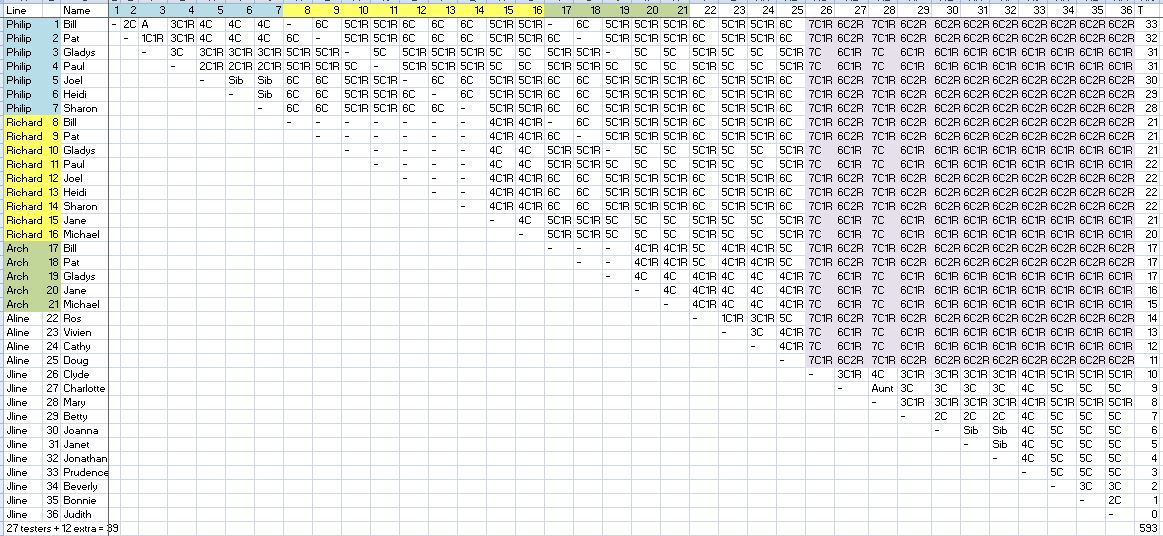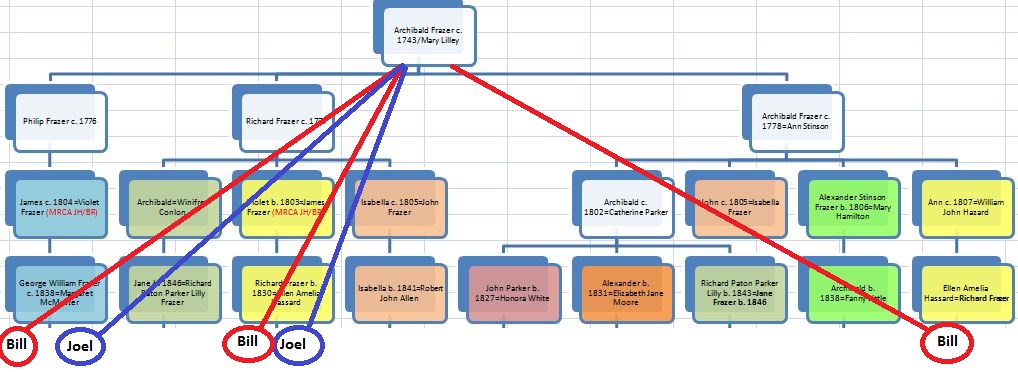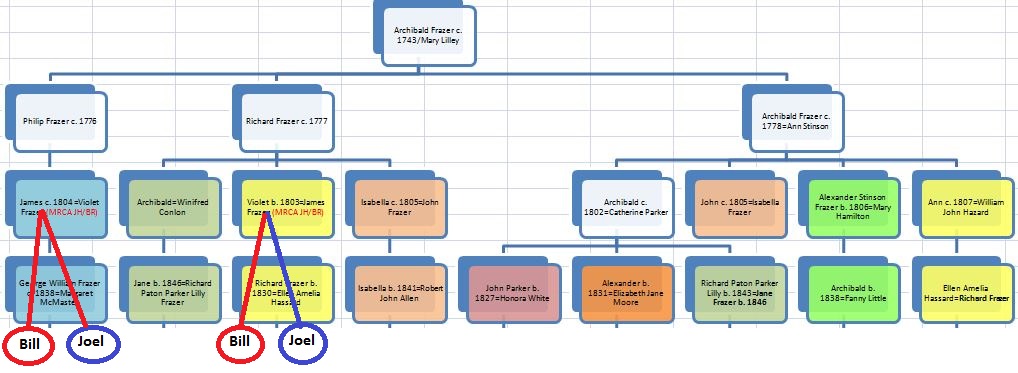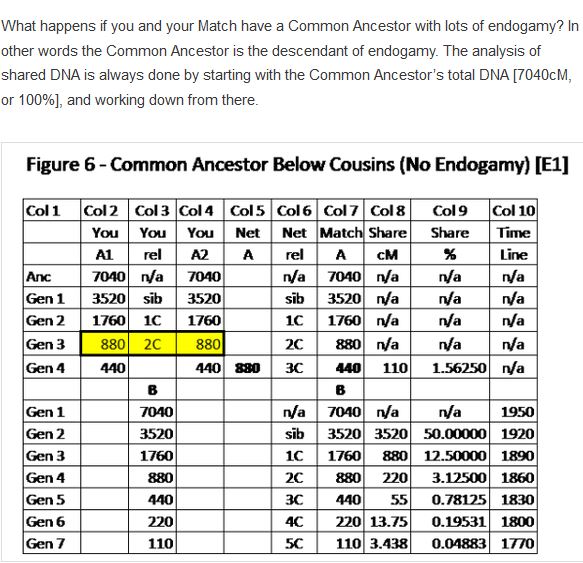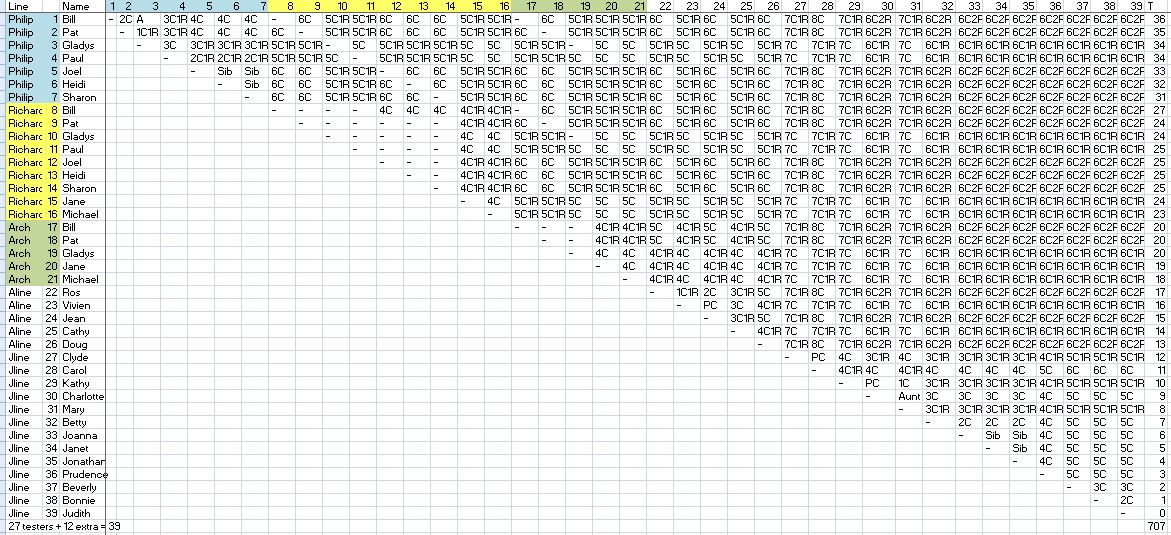Two blogs ago, I started looking at how many Frazer relationships there were. I looked at some of the cousin marriages and how that might effect the number of relationships. I proposed this formula to count the number of relationships
Number of testers minus one plus extra relationships due to intermarriage
I discussed the definition of a relationship and how it can be based on a common ancestor. Based on that, the formula could be:
Number of testers minus one plus extra common ancestors due to intermarriage
In the Frazer DNA project, there are 27 testers.
The first tester I looked at had 38 relatives and I enumerated each of those relationships. I also checked that number by the formula and was able to find 2 mistakes that I had made. Above, I reasoned that the second tester would have one less relationship as her relationship to the previous tester would already be listed. Going down the line I used the same reasoning for each of the 27 testers. I added the testers and got 675 relationships. I then checked to see how many relationships there would be if there were no additional common ancestors/relationships. I found out that due to the cousin marriages in the first decade of the 1800’s there were 324 extra relationships in the project.
any questions?
I felt a little uncomfortable using that number after just trying it out on one person. For one reason, the person I used had no known extra Frazer ancestors. I thought that I had better try this on Bill, one of our testers. He along with others in his family have 2 extra Frazer ancestors. I was worried that I might be counting too many or too few. For example, am I counting Bill being related to himself? Should I be? Or if Bill descends from 3 Frazer Lines, then should I be counting each version of Bill as he descends from those lines and relates to everyone else? This would be something like taking all the testers (27) subtracting one and then multiplying by 3 to get the ways that Bill relates to all of them? 26 time 3 is 78. This is quite a bit more than the 38 I came up with in my previous blog. But then I would think that Bill should not be counting his closer relative 3 times.
Let’s field test bill
Here is the simplified chart I am using to check Bill’s relationships:
I say ‘simplified’ because Bill is actually in the first blue column with me but he isn’t shown. In addition, my cousin Paul isn’t shown there. Bill’s cousin and aunt aren’t shown. Paul and my family aren’t shown on the first yellow long to save space. Two of Ros’ cousins aren’t shown on the purple line. Michael’s 2nd salmon line was abbreviated but actually continues down to him. The group that isn’t colored in is the James Line. In the Archibald Line on the left, I needed the color coding to keep the cousin marriages sorted out. If this was drawn true to life, the colored area would be a lot more built out.
Ground rules
- I won’t count Bill’s relatedness to himself as that seems weird. This mimics DNA testing also as you don’t find matches of yourself to yourself.
- I’ll try not to count duplicate relationships that shouldn’t be counted
- I will count each of the 3 versions of Bill as he is descended from Philip, Richard and Archibald Frazer and how he is related to everyone else in the project.
- I’ll look for a formula to keep everything straight – and save time for future counting.
I have a feeling that I’ll be close to my 78 number above.
Bill from Blue Line (PHilip)
- Bill to Patricia – 2C
- To Gladys – Aunt
- To Paul – 3C, 1R
- Joel – 4C
- Sharon – 4C
- Heidi – 4C
- Jane – 5C, 1R
- From Richard: Patricia – 6C
- Gladys – 5C, 1R
- Paul – 5C, 1R
- Joel – 6C
- Sharon – 6C
- Heidi – 6C
- Michael – 5C, 1R
- From Archibald: Ros – 6C
- Jean – 6C
- Vivien – 5C, 1R
- Cathy – 5C, 1R
- Jane – 5C, 1R
- Michael – 5C, 1R
- Doug – 6C
- Patricia – 6C
- Gladys – 5C, 1R
- Carol – 8C
- Clyde – 7C, 1R
- Kathy – 7C, 1R
- Charlotte – 6C, 2R
- Mary – 7C, 1R
- Betty – 6C, 2R
- Joanna – 6C, 2R
- Jonathan – 6C, 2R
- Janet – 6C, 2R
- Prudence – 6C, 2R
- Beverly – 6C, 2R
- Bonnie – 6C, 2R
- Judith- 6C, 2R
So there, I’m up to the 38 minus the 2 times I didn’t have Bill related to himself.
Bill from first Yellow line (Richard)
Now I have to make sure I don’t repeat any relationships. I’m tempted to call this 36 times 3 and call it quits. However, when I get to those within the yellow line (Patricia, Gladys, Paul, Heidi, Joel and Sharon) I think I need to skip them as the descent from James and Violet Frazer is pretty much the same as from Violet and James Frazer.
- From Philip: Gladys – 5C, 1R
- Carol – 8C
- Paul – 5C, 1R
- Joel – 6C
- Sharon – 6C
- Heidi – 6C
- From Richard: Jane – Now closer at 4C, 1R
- Michael – Now closer at 4C, 1R
- From Archibald: Ros – 6C
- Jean – 6C
- Vivien – 5C, 1R
- Cathy – 5C, 1R
- Jane – 5C, 1R
- Michael – 5C, 1R
- Doug – 6C
- Patricia – 6C
- Gladys – 5C, 1R
- Carol – 8C
- Clyde – 7C, 1R
- Kathy – 7C, 1R
- Charlotte – 6C, 2R
- Mary – 7C, 1R
- Betty – 6C, 2R
- Joanna – 6C, 2R
- Jonathan – 6C, 2R
- Janet – 6C, 2R
- Prudence – 6C, 2R
- Beverly – 6C, 2R
- Bonnie – 6C, 2R
- Judith
I think I did that right. The difference was we didn’t count the James and Violet descendants again.
Let’s Try Something Different
Rather than go one by one I decided to look at all the relationships in a grid. Gedmatch uses grids for some of their comparisons, and it seems like a good idea. My first version of this blog disappeared, so I’ll spare you from some of the previous mistakes I made.
In the above grid, I finished the descendants of Philip and started with the descendants of Richard in yellow on the left. I decided not to repeat the relationships between Bill’s family and mine here. That is because they are the same relationships and are from the same common ancestors of James Frazer and Violet Frazer that had already been counted from the blue section.
The last column is the sum of the relationships in a row.
Above is the start of the (green) descendants of Archibald. I only colored the areas where there were multiple descendants. Here I don’t include Bill’s 2nd cousin and Aunt as they were included previously with the same common ancestors – even though those common ancestors descended from different lines. However, I did include an extra relationship between Bill and Jane and Michael. Even though the relationship of 4th cousin once removed is the same as before, this time they have different common ancestors (Frazer/Stinson vs. Richard Frazer). I had mentioned that relationships are defined by the common ancestors, so I am trying to keep that definition consistently used.
And the Answer Is: 704
Somehow, I got the number of relationships up to 704 from 27 testers. Here’s the handy-dandy 704 relationship grid that no Frazer Project tester should be without:
Poor Judith at the bottom has zero relationships. Not really. Her Project number is 39, so her relationships can be read from the top right. This grid is a little bulky, so I decided to take out Jean from the Archibald Line and Carol and Kathy from the James Line. They have all had their mothers tested. So technically, their own results would not be as useful as their mother’s. Here is what the grid looks without them.
It doesn’t look much different, but it gets the number of relationships down to 593. [The correct total is in the next grid.] With the 3 taken out, that makes 13 Archibald Line testers and 11 James Line testers for a total of 24. If there were no additional relationships due to intermarrying with this number of testers, that would result in 276 relationships. So the early 1800’s Frazer marriages resulted in about 320 extra relationships in our project.
Here I have colored in the matches between the Archibald Line and the James Line (inter-line matches). Some observations:
- The shaded area is 11 by 25. That means that there are 275 ways for Archibald Line and the James Line testers to match each other.
- If our genealogy is right, the relationships between Archibald Line and James line is between 6th cousin, once removed and 7th cousin once removed.
- The triangle to the left of the shaded area represents matches between Archibald Line testers and other Archibald Line testers. The triangle beneath the shaded area represents matches between James Line testers to other James Line testers.
- The relationships favor the Archibald Line (larger triangle) which helps to explain the number of Triangulation Groups as well as overall matches as compared to the James Line.
- The James Line has 55 relationships counted (for matches just with other James Line testers).
- The Archibald Line has 263 relationships just among the Archibald Line. That’s about 5 times the potential relationships compared to the James Line
- I know that I have one other Frazer ancestor line, but I can’t place it. Is this all the extra Frazer Lines that are out there, or are there many more?
- The James Line relationship triangle is all filled in. This is due to no known cousin marriages there.
- The Archibald Line relationship triangle has people in it more than once and blank areas where I tried not to count duplicate relationships or one’s relationship to oneself.
- These relationship levels are based on genealogy which has not always been proven. However, the number of relationships should still be the same.
- It would be interesting to tabulate the numbers of different relationships per Line, tester, etc. This may also help to explain the matches that we have.
- There doesn’t appear to be a simple formula that could get us to this 704 number of relationship matches. My previous formula was an OK estimate.
- I haven’t verified every relationship.
Test driving the grid
Here is where the rubber hits the road. I want to see if the grid works.
- How many matches do I have? I add up my 2 horizontal Joel Lines for 30 and 22. Then I add up my vertical lines (#5 and 12). Those columns have 4 and 6 matches. That gives me a total of 62 relationship matches.
- How many times do I match Bill? I have highlighted 5 relationships. Logically one might think there would be 6, but I eliminated the extra relationship we had under James and Violet Frazer. That is where more of the dashes are. What are the 5 relationships I have with Bill? The first is 4th cousin (represented by the aforementioned James and Violet). The second is Bill’s descent from Philip related to my descent from Richard. The third is my descent from Philip to Bill’s descent from Richard. Note that both these last 2 relationships also had to go through James and Violet. So why did I add them? I look at it this way. Do your parents have common ancestors? Mine don’t that I know of. So I descend from them once. James and Violet had common ancestors, so that is why I am adding those common ancestors as my common ancestors resulting in an extra relationship. Finally my descent from Philip and my descent from Richard connects to Bill’s descent from Archibald to form the last 2 relationships. If I’m wrong, you can sue me for breach of relationship.
Well, I may be wrong: more on endogamy
In my previous blog, I wrote more on endogamy and relationships. Let’s take Bill and me for example. Bill and I are 4th cousins on the face of it. We are also 6th cousins. The below figure shows 6 of our 6th cousin relationships. Remember cousins are defined by the number of common ancestors they share. Here we share the same common ancestors 6 times. It looks like 5 times, but it there are 6 combinations or relationships between Bill and me: B1-J1, B1-J2, B2-J1, B2-J2, B3-J1, B3-J2.
Here is Bill and me with our 4th cousin relationships.
I tried to point my line to James in the first match and Violet in the second match. These are not endogamous relationships but there are 2 non-endogamous 4th cousin relationships that we have through common ancestors. It may seem like these were counted in the previous example, but they weren’t. That chart was counting 6th cousin relationships with the common ancestor of Archibald and Mary Lilley.
As a result, it looks like I am related to Bill 8 times, not the 5 I mentioned above. Unfortunately, my relationships chart above, only has room for 6 relationships. Rather than revise my chart, I think I’ll just bump Bill and my relationships up to 6 from 5. I’ll make that 2 – 4th cousins and 4 – 6th cousins.
taking it one step further
Now what about my cousin Paul and I? We are 2nd cousins once removed. We both have as a common ancestor George Frazer b. about 1838. He is in the blue line and the first yellow line. Am I related to him once or twice? According to the Segmentology blog, it appears that it should only be once. Here is a screen shot from the Segmentology Endogamy I Blog, that I didn’t cover in my previous Blog:
And here is my ancestry showing that George Frazer appears in my ancestry only once:
The colored charts I had above made it confusing as it looked like George was in my ancestry twice, but that was because I had him coming down from two lines. Those lines actually merge into [one] George William Frazer as shown above. The bottom line is that I should only be counting my relationship with Paul once. This would also apply to Bill, his Aunt Gladys and his cousin Pat.
So all that work and I only added 3 relationships. There are other relationships out there, but I guess we only count them for the purposes of endogamy and extra DNA matches.
Final? Count of 707
I’ll stick to this chart for now.
